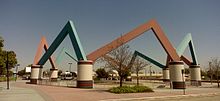Foothill Extension
The project begins at the former terminus of the former Gold Line at Sierra Madre Villa station in Pasadena and continues east through the "Foothill Cities" of Los Angeles County.In addition to enhancing mobility in one of the most congested metropolitan areas in the United States, the 23.8-mile project (38.3 km) is seen as an economic catalyst for the region, generating 6,900 jobs during the construction phase and creating infill and transit-oriented development opportunities.On February 28, 2007, the Construction Authority Board certified the final EIR and decided to complete the "LRT Build to Azusa" alternative.[15] In October 2009, the Los Angeles County Metropolitan Transportation Authority (Metro) board of directors unanimously voted to include the Gold Line Foothill Extension in its long-range plan and approved funding for the construction and operation of Phase 2A.A groundbreaking ceremony for Phase 2A was held on June 26, 2010;[16] construction began the following summer and was completed in September 2015, with the extension entering service on March 5, 2016.[18] Phase 2A is 11.5 miles (18.5 km) long and included stations at Arcadia, Monrovia, Duarte/City of Hope, Irwindale, Azusa Downtown, and APU/Citrus College, as well as a new Division 24 Maintenance and Storage Facility.The final EIR for the project was certified by the Foothill Gold Line board in March 2013, and advanced conceptual engineering began in 2014.[27] Metro allocated $798 million of SB125 funding to complete the Los Angeles County portion of the Pomona to Montclair project.On July 11, 2024, the Foothill Gold Line board of directors unanimously voted to work with Kiewit Corporation as their contractor to build the Pomona to Montclair project.[35] In 2008, the Foothill Gold Line Construction Authority commissioned a study by KOA Corporation to determine the feasibility of such an extension, which they dubbed "Phase 2C.[41] Holden would be aided by California State Senator Anthony Portantino (D-La Cañada Flintridge), representing California's 25th senatorial district, who introduced his bill, SB 1390, on February 21, 2020, which went even further and would've transferred taxpayer funds and land owned by the SBCTA within the proposed rail right of way to a state-created independent construction authority.The board voted to oppose both bills and passed a motion reasserting itself as the sole authority to plan, design, and build new mass transit projects in San Bernardino County.On May 18, 2020, the SBCTA ceased negotiations on a memorandum of understanding (MoU) on the extension, following Holden committing against further action on his legislative proposal, killing these attempts at the project.[44] As a cost-effective solution compared to the proposed extension, estimated at around $1–1.5 billion,[45] SBCTA and Ontario International Airport are currently in the process of trying to implement a tunnel with autonomous, zero-emission vehicles on an "on-demand" basis from the Metrolink San Bernardino Line's Rancho Cucamonga station to Ontario International Airport.[46] Initially, The Boring Company proposed constructing a single 2.8-mile (4.5 km) tunnel similar to the Las Vegas Convention Center Loop that would cost $60 million.

Foothill FreewaySierra Madre Villa stationLos AngelesPasadenaPomonaSierra Madre VillaAPU/Citrus CollegePomona NorthMontclairLight railLos Angeles Metro RailMetro (LACMTA)Track gaugeElectrificationOverhead lineSan Bernardino LineSan Bernardino–DowntownClaremontL.A. Union StationLa Verne/FairplexSan DimasSR 57SR 210GlendoraAzusa DowntownIrwindaleDuarte/City of HopeMonroviaArcadiaLong BeachA LineGold LineLos Angeles CountyAPU/Citrus College stationPomona North stationMetrolinkMontclair TranscenterSan Bernardino Countyjoint powers authorityLos Angeles County Metropolitan Transportation AuthoritySan Bernardino County Transportation AuthoritySouth Pasadenatransit-oriented developmentRegional ConnectorAtchison, Topeka & Santa Fe RailwaySecond DivisionSan Gabriel MountainsSan GabrielHuntington DriveFoothill Boulevarddraft environmental impact reportFoothill TransitSilver StreakClaremont stationGovernor of CaliforniaGavin NewsomCalifornia State Transportation AgencyCalifornia State SenateKiewit CorporationCitrus CollegeCalifornia Public Utilities CommissionOntario International AirportOntarioKOA CorporationSan Bernardino Associated Governmentspublic transportSouthern California Association of GovernmentsSan Gabriel ValleySan Bernardino ValleyHolt BoulevardCalifornia State AssemblymanChris HoldenCalifornia's 41st State Assembly districtCalifornia State SenatorAnthony PortantinoLa Cañada FlintridgeCalifornia's 25th senatorial districtright of waystate legislatorsmemorandum of understandingRancho Cucamonga stationThe Boring CompanyLas Vegas Convention Center LoopSan Gabriel Valley TribuneDigital First MediaLos Angeles Daily NewsMediaNews GroupNexstar Media GroupKABC-TVVox Media Inc.Inland Valley Daily BulletinDaily BulletinLos Angeles TimesYouTubeCBS NewsBuswayMemorial ParkDel MarFillmoreHighland ParkSouthwest MuseumHeritage SquareLincoln/CypressChinatownUnion StationLittle Tokyo/Arts DistrictHistoric BroadwayGrand Avenue Arts/Bunker Hill7th Street/Metro CenterGrand/LATTCSan Pedro StreetWashingtonVernonSlausonFlorenceFirestone103rd Street/Watts TowersWillowbrook/Rosa ParksComptonArtesiaDel AmoWardlowWillow StreetPacific Coast HighwayAnaheim Street5th Street